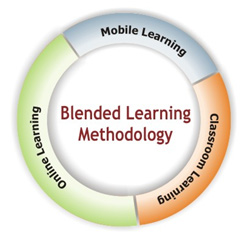Include Mobile When Blending Courses

Blended learning is not a new course design concept. It refers to a mixing of different learning environments. Usually, that means blending traditional face-to-face (F2F) classroom methods and class time with online and computer-mediated activities.
There is not one definition of blended learning. In fact, I hear the terms "blended," "hybrid," and "mixed-mode" used interchangeably.
In blended learning, technology always plays a bigger role than in the traditional classroom. As schools "allow" and actually encourage the use of smartphones and tablets, these devices allow the F2F experience to overlap with the experiences outside the classroom. Students bringing their own devices to campus (known as BYOD) changes things. It changes technology policies and it lowers the cost of technology for blended-learning. Statistics are always changing but at least 75 percent of teens now own cellphones, according to a Pew Research Center report. Is there a socio-economic, racial "gap" with mobile technology as there was in the early days of personal computers and Internet access? Another Pew study reported that African Americans and English-speaking Hispanics are slightly more likely than whites to own a cell phone.
Students bringing their own devices to campus (known as BYOD) changes things. It changes technology policies and it lowers the cost of technology for blended-learning. Statistics are always changing but at least 75 percent of teens now own cellphones, according to a Pew Research Center report. Is there a socio-economic, racial "gap" with mobile technology as there was in the early days of personal computers and Internet access? Another Pew study reported that African Americans and English-speaking Hispanics are slightly more likely than whites to own a cell phone.
Remember 1:1 computing? Mobile devices, particularly smartphones, bring us much closer to that as a reality. And that also makes blended learning more viable.
The real blending may occur when students don't see a big difference between the experience in a classroom and the experience outside.
Mobile doesn't eliminate all the issues with blended courses - and many of those issues have been around since the earliest days of online learning. Some things are harder to do - maybe impossible - to do online. Assessments on mobile devices require considerations of academic integrity.
But anyone considering designing or teaching in a blended setting needs to be be making mobile part of the design.
Comments
No comments